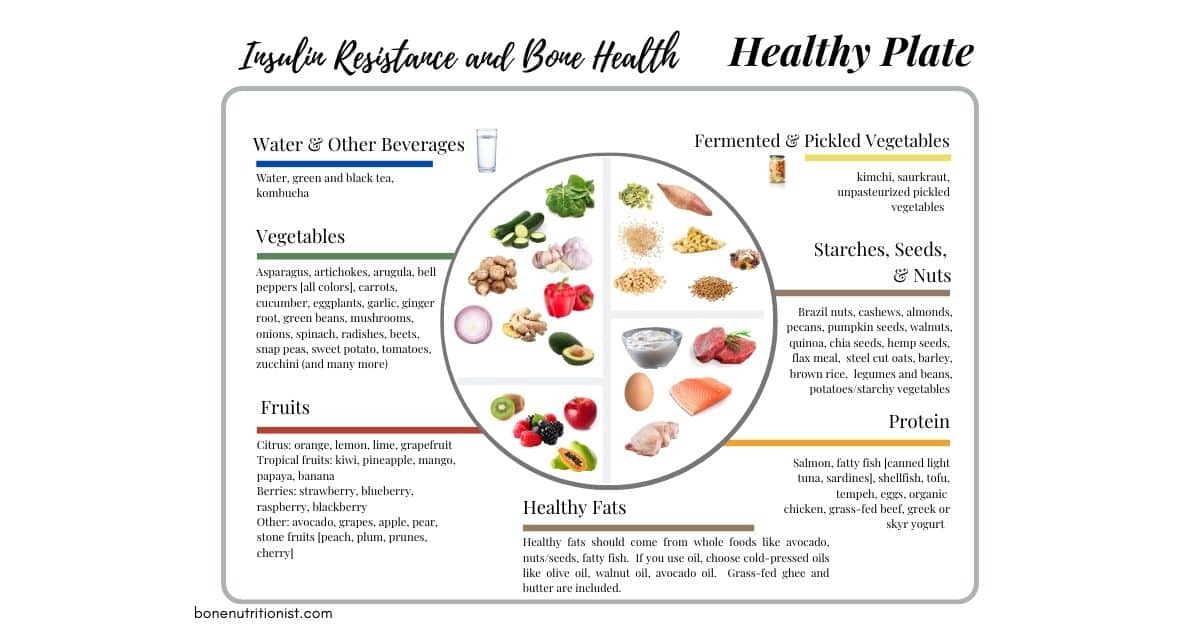Here’s your chance to get a free Insulin Resistance Meal Plan PDF. Insulin resistance is a metabolic condition characterized by the body’s reduced response to insulin, a hormone important for regulating blood sugar levels. When cells become resistant to the effects of insulin, glucose struggles to enter cells efficiently, leading to elevated blood sugar levels and weight gain.
Continued insulin resistance can contribute to the development of different health issues, such as type 2 diabetes, cardiovascular disease, and obesity. Additionally, insulin resistance is associated with increased inflammation and a higher risk of developing metabolic syndrome.
In this blog article, we provide you with a few key strategies to reduce insulin resistance with nutrition. We also include a 7-day insulin resistance meal plan in pdf format that includes recipes and a grocery shopping list.
Insulin Resistance and Bone Health
Insulin resistance is also associated with lower bone density. It’s not totally understood how insulin resistance can impact bone health but inflammation may play a part and often a diet that promotes insulin resistance doesn’t have the right balance of nutrients to support optimal bone health.
By addressing insulin resistance, you can reduce these risks and enhance overall health. Adopting lifestyle changes, including a balanced diet, regular physical activity, and weight management, are effective strategies to help you reduce insulin resistance.
Prioritizing these changes can lead to improved insulin sensitivity, helping to maintain stable blood sugar levels and reduce associated health complications.
Understanding How Food Impacts Glucose and Insulin Resistance
Foods high in refined carbohydrates and added sugars can contribute to insulin resistance by causing rapid spikes in blood sugar levels. These elevated blood sugar levels trigger the pancreas to release more insulin, leading to a continuous cycle of increased insulin production. Over time, this can contribute to the development of insulin resistance.
On the other hand, consuming a balanced diet that is protein-focused with fiber-rich foods, nutrient dense carbohydrates and healthy fats will help you regulate blood sugar levels and supports insulin sensitivity.
Antioxidant-rich fruits and vegetables also play a role in reducing inflammation associated with insulin resistance. Therefore, making mindful food choices, focusing on nutrient-dense options, and maintaining a balanced diet are key factors in managing and preventing insulin resistance.
Building a Balanced Plate for Insulin Resistance and Bone Health
Building a balanced plate is helpful for insulin resistance and stabilizing or reducing your glucose levels. Prioritizing protein helps balance glucose levels, improves appetite/satiety and is important for building bone and muscle. Protein is one macronutrient you never want to leave off your plate. A general good protein goal for each meal is around 30 grams.

Focus on Protein For Insulin Resistance
In our blog post on protein for bone health, you’ll see that 1.2 to 1.5 g per kilogram of body weight is recommended for bone health. That’s also a good protein target to have for reducing insulin resistance because protein helps stabilize glucose levels. Some good sources of protein are: fatty fish [tuna, salmon, tilapia, sardines], shellfish, tofu, tempeh, eggs, organic chicken, grass-fed beef, elk, bison, greek or skyr yogurt.
High-Fiber Non-Starchy Veggies Help Stabilize Glucose Levels
After protein, the next priority is non-starchy vegetables. The fiber in non-starchy vegetables is helpful at stabilizing glucose levels because fiber helps slow down the digestive process. Non-starchy carbs don’t have a lot of carbohydrates that turn into glucose so this helps as well. Non-starchy vegetables are nutrient dense and help fight inflammation, which helps reduce insulin resistance.
Healthy Fats Help With Satiety and Glucose Levels
Include healthy fats from sources like avocados, seeds, nuts, and olive oil to further enhance satiety and support stable blood glucose levels. For information on how many whole grains, fruits, and legumes you should eat, get the Insulin Resistance Meal Plan PDF guide. The guide includes how to build a balanced plate and a 7-day meal plan with recipes and a grocery list.
Please know that the meal plan serves as a general guide. Everyone has individual nutrition needs based on weight, activity and their own personal metabolism and health status. Consider consulting with a registered dietitian for personalized guidance on how many grams of protein, carbs and healthy fats you should have each day.
Limiting Carbs For Insulin Resistance
In general, most people with insulin resistance need to limit carbohydrates, even if the carbs they eat are intact and in whole food form.
A good rule that works for most people in stabilizing glucose levels is to follow a 1:2 ratio of protein to carbs. So, for every one gram of protein, you would limit carbohydrates to no more than 2 grams. That rule can be helpful in planning meals and choosing foods that have a food label. Depending on one’s level of insulin resistance, carbohydrates might have to be limited even more.
Portion control is also essential. Over consuming calories, whether the calories come from protein, carbs or fats, can lead to weight gain and insulin resistance.
Hydration Helps with Insulin Resistance
Don’t forget to drink your water. Being dehydrated even just a little can increase glucose levels. We recommend 96-110 ounces of water each day. If you’d like to learn more about hydration and health, Andrew Huberman with Huberman Lab has an excellent podcast episode on optimizing your health with water.
Insulin Resistance Meal Plan PDF & Bone Health Plate Guide
Managing or reversing insulin resistance is possible and what you eat makes a big difference. Check out our comprehensive meal plan guide, accompanied by a downloadable PDF (just below). Remember that consistency is key, and consulting with a registered dietitian can provide personalized insights catered to your health and lifestyle. Be sure to grab your copy of the Insulin Resistance Meal Plan PDF guide.
Jen is a Registered Dietitian Nutritionist, Certified Diabetes Educator and experienced nutrition editor. She currently works as a private practice dietitian providing virtual consultations for people with osteoporosis, insulin resistance, weight management and more. She has a never-ending passion for education and enjoys sharing ways to optimize bone health and improve insulin resistance.

